A sweeping health care proposal advancing through Congress threatens to strip medical coverage from millions of Americans, with communities of color bearing the heaviest burden of the potential changes. The Congressional Budget Office has calculated that the proposed Medicaid modifications could leave 7.8 million additional Americans without health insurance by 2034, representing a dramatic reversal of coverage gains achieved over the past decade.
The Senate Finance Committee has crafted legislation that fundamentally restructures Medicaid funding mechanisms while introducing unprecedented work requirements for recipients. This comprehensive overhaul forms a central component of President Donald Trump’s signature legislative package, which Republican leadership aims to deliver for presidential approval by July 4th.
The timing and scope of these changes have created intense debate about health care equity and access, particularly as the modifications would most severely impact populations that have historically faced barriers to medical care. The projected coverage losses represent one of the largest potential reductions in health care access since the implementation of major federal health programs.
Provider tax restrictions reshape state funding strategies
The legislative proposal introduces significant constraints on how states can finance their Medicaid programs through provider taxes. Under current regulations, states can impose taxes on health care providers up to 6% of total program costs, but the new framework would reduce this ceiling to 3.5% by 2031 for states that expanded Medicaid coverage.
This reduction specifically targets the 40 states plus Washington D.C. that chose to extend Medicaid eligibility to low-income adults under previous health care expansions. The provider tax limitations would force these states to either reduce services, find alternative funding sources, or potentially withdraw from expanded coverage options entirely.
States that declined to expand Medicaid programs would face different restrictions, with caps imposed on their ability to increase existing provider tax rates. This two-tiered approach creates distinct impacts across different regions, with many Republican-led states receiving more favorable treatment under the proposed tax structure.
Work requirements create unprecedented eligibility barriers
The legislation establishes work mandates for Medicaid recipients that have never before existed in the federal program. Parents with children aged 15 and older would need to demonstrate at least 80 hours monthly of employment, volunteer service, or job training activities to maintain their health care benefits.
These work requirements represent a fundamental shift in Medicaid’s structure from a safety net program to one with conditional eligibility based on employment status. Disability advocacy organizations have expressed particular concern about how these mandates might affect individuals with disabilities who face employment challenges or require flexible work arrangements.
The implementation of work requirements could create administrative burdens for both recipients and state agencies responsible for monitoring compliance. States would need to develop tracking systems and verification processes while recipients navigate complex reporting requirements that could jeopardize their coverage for administrative errors.
Disproportionate impact on minority health care access
Research data consistently demonstrates that Black and Hispanic Americans rely on Medicaid at higher rates than other demographic groups, making these communities particularly vulnerable to coverage reductions. The Economic Policy Institute has documented how previous health care expansions significantly reduced uninsured rates among minority populations, gains that could be reversed under the proposed changes.
Health care access disparities that existed before recent coverage expansions could resurface and potentially worsen if millions lose Medicaid eligibility. Communities of color often face additional barriers to obtaining private insurance, including lower average incomes and reduced access to employer-sponsored coverage options.
Rural hospitals and health care providers serving predominantly minority communities could face severe financial pressures if large numbers of patients lose Medicaid coverage. These facilities often depend heavily on Medicaid reimbursements to maintain operations and provide essential services to their communities.
Congressional dynamics shape legislative timeline
Democratic members of the Senate Finance Committee have mounted opposition to the proposed cuts, emphasizing potential harm to vulnerable populations and health care infrastructure. However, Republican control of the committee and broader Congressional majorities provide momentum for advancing the legislation despite Democratic objections.
The ambitious July 4th deadline creates pressure for rapid consideration of complex health care policy changes that could affect millions of Americans. This compressed timeline limits opportunities for detailed analysis of implementation challenges and unintended consequences that might emerge from such sweeping modifications.
Health care advocacy organizations across the political spectrum have called for more thorough examination of the proposal’s impacts before final passage. The scale of projected coverage losses has prompted warnings about potential public health consequences and economic effects on health care systems nationwide.
















